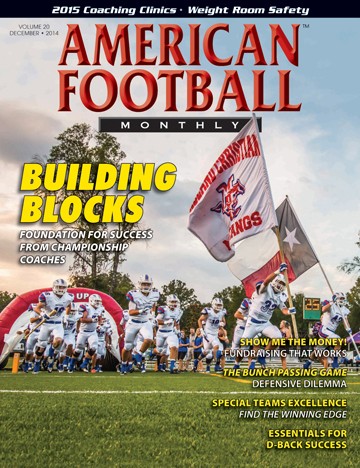Wild Bunch - Stress out defenses with the Bunch Passing Game
by: Matt KubikOffensive Coordinator, Stephen F. Austin State University©
More from this issue
We have had success with our ‘Bunch’ passing game. There are four major advantages of using the bunch pass:
• It allows you to get wide receivers open based on scheme, not one-on-one matchups.
• The bunch game will loosen up man coverage schemes.
• It makes the defense spend practice time trying to defend it.
• It creates advantages in the run game by spreading the defense out.
There are four basic bunch plays that we use on a regular basis – Spider, Follow, Dig and Z-Shallow. Here are the responsibilities of the skill players for each one.
Spider (Diagram 1)
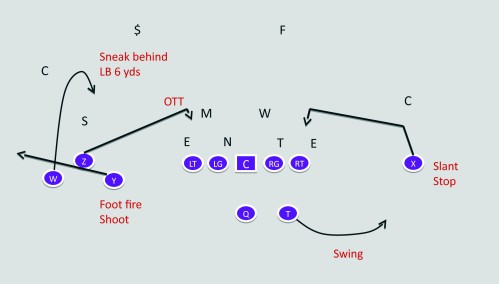
Spider is a spacing concept and we pair it with our quick game 5-man protection.
Bunch Side:
W – Runs the snag route. He will push up vertical to 6 yards curl back to 5 yards over the split of the Z. He is trying to get behind the eyes of the LB over the Z and wrap behind him.
Z – Sets the split on the hash and is running an OTT (over the tackle). His landmark is 5 yards deep directly over the near tackle. He must have his head around at the snap where the QB can hit him on the run in “hot” situations.
Y – Runs the shoot route. He is the last one of the three to get into his route. He gives a quick 1,2,3 foot fire, then runs flat no deeper than one yard past the LOS.
Backside:
X – Runs a slant stop. He has a 3-step slant at 5 yards, shutting in down when he gets over the near tackle. He must have his head around also so the QB can hit him on the run in “hot” situations as well.
T – Runs a free release swing route into the boundary.
QB Read:
We want to play the front side in zone looks. It is a read off of the flat defender. Most teams play the bunch with a LB over the point man. In the diagram, the “S” is the flat defender. The QB will throw the snag or shoot based on who the flat defender works to. The OTT (over the tackle) comes into play in “hot” situations to the field or if one of the LBs in the box vacates to get under the snag. Our philosophy is to only work backside vs. a boundary blitz.
Follow (Diagram 2)
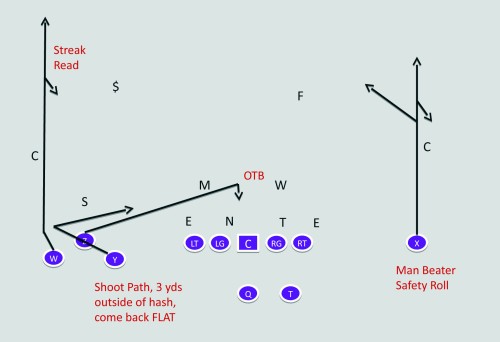
Follow is a high-low concept, paired with 6-man protection.
Bunch Side:
W – Runs a “Streak Read”. He has two options – a streak or curl. He takes a vertical release through 10 yards and reads the safety over him. If the safety squats, he’ll run a streak. If the safety plays over top of him, he’ll sit down and work back to the QB.
Z – He sets the split on the hash. He is running an OTB (Over the Ball). His landmark is 5 yards deep directly over the ball. He must have his head around at the snap so the QB can hit him on the run in “hot” situations.
Y – Runs the follow route. He runs a shoot route one yard deep. When he gets 3 yards outside the hash, he returns back inside, the flatter the better.
Backside:
X – Tagged man beater route.
T – Checks his protection rules, then runs tagged route.
QB Read:
We want to play the front side vs. the two-high safety route, any safety look, or man-play backside. It is a high-low read off of the flat defender with most teams playing the bunch with a LB over the point man. In the diagram, the “S” is the flat defender. The QB will read it high to low and if the streak read takes it, he has the option to throw the deep ball. If he sits it down, the QB high-lows the LB. The OTT comes into play in “hot” situations to the field or if one of the LBs in the box vacates to get under the follow route.
Dig (Diagram 3)
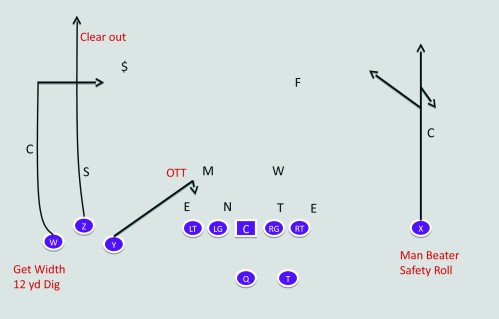
Dig is a high-low concept, paired with 6-man protection.
Bunch Side:
W – Runs a dig. He widens the CB over him and runs a controlled cut dig cut at 12 yards.
Z – Sets the split on the hash. He runs an outside release out, attacking the safety to make room for the dig underneath him.
Y – Runs a OTT. His landmark is 5 yards deep directly over the near tackle. He must have his head around at the snap. The QB can hit him on the run in “hot” situations.
Note: The Z has the option to make a “switch” call vs. a hard pressing LB over him. The “switch” call alerts the Y. He now runs the “clear out” and the Z has the “OTT”. Z will foot fire and let the Y go first.
Backside:
X – Tagged man beater route
T – Checks his protection rules, then runs a tagged route.
QB Read:
We want to play the front side vs. a two-high safety look, any safety roll or man-play backside. It is a high-low read off of the flat defender. Most teams play the bunch with a LB over the point man. In the diagram, the “S” is the flat defender. During the clear out, the QB can see who is open. His read is to play the dig down to the OTT. The OTT comes into play in “hot” situations again.
Z-Shallow (Diagram 4)
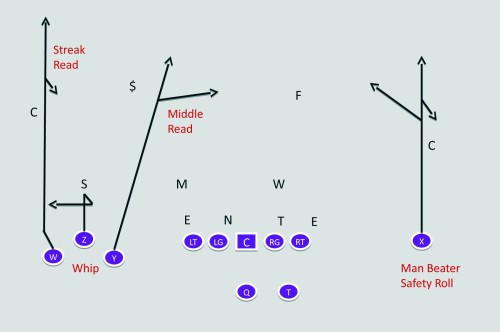
Z - Shallow is a high-low concept, paired with 6-man protection.
Bunch Side:
W – Runs a “Streak Read”. He has two options - a streak or curl. He takes a vertical release through 10 yards and reads the safety over him. If the safety squats, he’ll run a streak. If the safety plays over the top of him, he’ll sit it down and work back to the QB.
Z – Sets the split on the hash. He runs a shallow route. He then pushes up 5 yards and whips out to the flat.
Y – Runs a “Middle Read” route. He takes a vertical release to the near upright. If the safety stays two high, he continues to the near upright. If we get a one high look or the boundary safety rolls to the field, the Y snaps a dig off to cross his face at 10 yards.
Backside:
X – Tagged man beater route.
T – Checks his protection rules, then runs tagged route.
QB Read:
We want to play the front side vs. a two-high safety look, any safety roll or man-play backside. It is a high-low read off of the flat defender. Most teams play the bunch with a LB over the point man. In the diagram, the “S” is the flat defender. The QB can peak the middle read vs. a wide two safety look. The QB will read it high to low. If the streak read takes it, he has the option to throw the deep ball. If he sits it down, he high-lows the LB.
About the Author:
Matt Kubik just completed his first season as OC at Stephen F. Austin State University. He previously coached at both Central Arkansas and Northwestern State. Kubik was a two-year starter at QB at Louisiana Tech, earning his degree in 2005.
